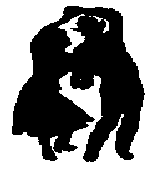|
 |
  |
 |
What is Linedancing?
A short essay that attempts to provide answers to what line dancing is and how it came to be. Feel free to disagee - it's just a few thoughts and opinions.© David Powell, January, 2003.
(Note: In the following I use 'linedance' to
refer to the style of dance that this site is focused on. The phrase 'line
dance' is used to refer to any dance in which the dancers are in a line,
which includes linedancing, but not exclusively. This distinction is merely
to reduce possible confusion - I am well aware that in linedancing circles
the two terms are used interchangably).
![]()
Definitions
Trying to find a definition of linedancing is nigh on impossible. Those of us who do it know what it is (hopefully!), but an actual description is not something I've come across. This confusion as to just what linedancing is ranges all the way from the greenest novice to those at the other end of the experience scale - and if you find that hard to believe, just look at some of the categories and dances done at the various linedance competitions around the world. Just as hard to define is just where and how linedancing came about to be. In the following essay I've attempted to answer both - at least my views, for what they may be worth. J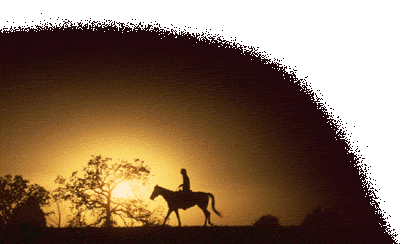
Linedancing is a choreographed form of popular dance incorporating a repeating sequence of steps and which is identically performed by a group of dancers in one or more lines.
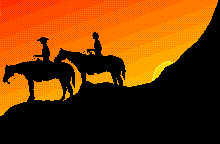 According
to the experts, dancing can be either popular or performance.
Performance dancing is pretty much what it sounds like - one or more people
dancing in front of an audience. Popular dancing, on the other hand, is,
to pinch a phrase, dancing "by the people, for the people". Of course,
now that linedancing has become an established dance form, there are many
exponents who utilise it in what can really only be called "performance
dancing". A classic example of this would be the dance troupe "Hotfoot",
a group of young linedancers who travel around Australia with a several-hour
dance show that is, at least in origin, linedancing. They are but one of
many such groups, both here in Australia and elsewhere. Competition linedancing
is also arguably performance rather than popular dancing - both because
it is performed by a small number of dancers (sometimes even as a solo
performance) in front of an audience and the difficulty of the dance is
often quite high. The emphasis on 'popular' is, however, important because
there are forms of performance dancing which are done in lines but which
are not considered to be linedancing. Chorus line dancing is a good example
of this. The fact that a chorus line dance would not be out of place in
linedancing emphasises the significance of popular vs performance in the
definition. Incidentally, while linedancing has sometimes been called "Country
Dancing", Country Dance is actually the name of a form of folk dancing
that arose in Medieval Britain.
According
to the experts, dancing can be either popular or performance.
Performance dancing is pretty much what it sounds like - one or more people
dancing in front of an audience. Popular dancing, on the other hand, is,
to pinch a phrase, dancing "by the people, for the people". Of course,
now that linedancing has become an established dance form, there are many
exponents who utilise it in what can really only be called "performance
dancing". A classic example of this would be the dance troupe "Hotfoot",
a group of young linedancers who travel around Australia with a several-hour
dance show that is, at least in origin, linedancing. They are but one of
many such groups, both here in Australia and elsewhere. Competition linedancing
is also arguably performance rather than popular dancing - both because
it is performed by a small number of dancers (sometimes even as a solo
performance) in front of an audience and the difficulty of the dance is
often quite high. The emphasis on 'popular' is, however, important because
there are forms of performance dancing which are done in lines but which
are not considered to be linedancing. Chorus line dancing is a good example
of this. The fact that a chorus line dance would not be out of place in
linedancing emphasises the significance of popular vs performance in the
definition. Incidentally, while linedancing has sometimes been called "Country
Dancing", Country Dance is actually the name of a form of folk dancing
that arose in Medieval Britain.
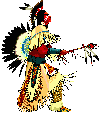 The
emphasis on linedancing being choreographed is important
in order to distinguish it from other forms of popular dance that also
involve a series of repeating steps and are danced in lines. Many forms
of folk dancing involve dancing in lines, from Amerindian dances, to those
of the Pacific Islanders (e.g.: the Hula dance) and Europe (e.g.: the English
Morris Dance). Folk dancing, however, is not choreographed as such and
the steps have evolved over the centuries. Whilst folk dancing is obviously
one of the roots for linedancing, linedancing is not considered a form
of folk dancing, if only because it is too new and folk dance is a traditional
dance form.
The
emphasis on linedancing being choreographed is important
in order to distinguish it from other forms of popular dance that also
involve a series of repeating steps and are danced in lines. Many forms
of folk dancing involve dancing in lines, from Amerindian dances, to those
of the Pacific Islanders (e.g.: the Hula dance) and Europe (e.g.: the English
Morris Dance). Folk dancing, however, is not choreographed as such and
the steps have evolved over the centuries. Whilst folk dancing is obviously
one of the roots for linedancing, linedancing is not considered a form
of folk dancing, if only because it is too new and folk dance is a traditional
dance form.
Tags, phrasing and restarts aside (and many would love to leave them
aside), linedancing involves the repetition of a sequence
of steps for the duration of the music. The sequences, often called a "wall",
most commonly last for 32, 48 or 64 beats of the music and the dance itself
is defined as the sequence. Each repetition is identical to all the others
(personal styling aside). This repetition of identical sequences distinguishes
linedancing from many other forms of dancing done in lines. The dancing
featured in many music video clips does not involve the repetition of an
identical sequence, nor does chorus line dancing and folk dancing. Each
of these styles may have some repeating sequences, but the dances themselves
are not defined by the sequence.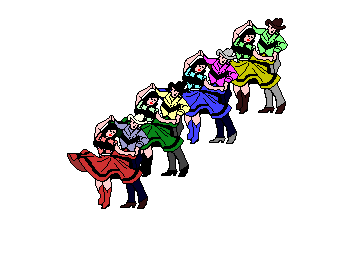
The last part is pretty self explanatory - linedancing is identically performed by a group of dancers in one or more lines. This is inherent in the very name, "linedancing". Whilst this is true of other forms of dancing, it does distinguish it from other forms of modern popular dance which may even be done to the same music and involve many of the same steps. Disco, rap, dance club, rock 'n roll etc. dances are all solo or partner dances. Each dancer is dancing by themselves (or with their partner), independently of anyone else on the dance floor. Doing the same step at the same time and facing the same direction is more a matter of coincidence than intent with these other forms of modern popular dance.
Combined, the definition is not foolproof - arguably no definition can
be - but it does cover the essential basics and does distinguish almost
all linedancing from other forms of dance. Some competition linedances
do not fit in with my definition, but IMO that is not a failing of the
definition, but rather that those dances are not linedances. By definition
one person does not make a linedance. There are also the various tags,
restarts and multi-part dances - while these do not fit in with the 'repetitive
sequence', dances with tags etc. still involve repetitive sequences.
![]()
Origins
Trying to define linedancing is hard enough, trying to find its origins is perhaps harder still.Just what is meant by 'origin' can help answer this question - or at least provide a answer. One can view the history of linedancing in four stages: roots, genesis, birth and evolution. There is, of course, a considerable degree of overlap between these stages, but they, at the least, are helpful in tracing the origins of linedancing. This is also complicated in that while throughout much of its history linedancing has had a country flavour and there are distinct and obvious influences from country and western dancing and other traditional American dance styles, this country flavour came after linedancing was born. By Roots, I mean those forms of dance to which linedancing ultimately can be traced back to. Genesis was how those roots came together. Birth was linedancing's first recognisable appearance; and Evolution traces the changing nature of linedancing from it's birth to the present day.
Roots
The difficulty of determining the roots of linedancing is that many dance forms are similar and while, on the face of it, there may seem to be a link between one historical dance form and linedancing, in reality there is probably no way of knowing for sure. The best one can do is to suggest possible roots for linedancing.Linedancing ultimately has its roots in European folk dancing. I've
already mentioned folk dance above, but for a brief description: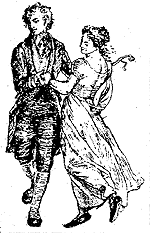
"A participatory dance form, folk dance is usually traditional and performed by members of a community. Although not easy to define, the term seems best to fit those dances originated by agricultural peoples for secular and sometimes ritual purposes, in countries that also have an art form of dance. The Balkan kolo, English morris dance, and North American square dance are examples, as are Maypole dances and the different kinds of sword dance. Folk dances are usually group forms that are passed from one generation to another ... Varying criteria have been used to differentiate folk dance from other kinds of dance: For example, the dancers are said to belong to a certain economic level or come from certain locales; the steps are simple and repeated, so that any member of the community can participate; the dances require no audience; and they are passed down through many generations. Each of these criteria can be contradicted by dances that are indisputably folk dances, and in each of these criteria, folk dance overlaps with other kinds of dance." Microsoft Encarta, © 1994.It should be noted that most well established western dance forms are ultimately derived from folk dance. The waltz, for instance, is derived from the Austrian "lšndler". Folk dancing is not just a European thing - it is world-wide, tho' the folk dances of many cultures are termed "tribal dances", no doubt a hang over of western colonialism. Folk dancing, like linedancing, is a popular dance form rather than a performing dance form - that is, those dancing are doing so for their own enjoyment rather than to entertain others. Many folk dances are composed of repetitive, easy-to-learn steps, however this is by no means the rule.
The floor pattern of folk dances falls into one of two groups - circle
dances and chain dances. Circle dances are the most common and, naturally
enough, involve the dancers moving in a circle or ring. Almost as common
are the chain dances where the dancers are in a line, said line may be
straight or spiralled, the dancers may follow each other or be side by
side. A much less common form of folk dance are the "longways dances",
in which the dancers are in parallel lines. This is the case with the British
"country dances" and the folk dances of the Pacific islanders.
 Linedancing
arose in the USA so it is those particular folk dances (and their immediate
successors) which emigrated to the USA which can be directly pointed to
as the roots of linedancing. Whilst, for example, the folk dancing of the
Pacific islanders bears a remarkable similarity to modern-day linedancing,
it is unlikely there is any direct connection and the similarity is just
coincidence - the two dance forms have evolved in parallel, but independently.
Linedancing
arose in the USA so it is those particular folk dances (and their immediate
successors) which emigrated to the USA which can be directly pointed to
as the roots of linedancing. Whilst, for example, the folk dancing of the
Pacific islanders bears a remarkable similarity to modern-day linedancing,
it is unlikely there is any direct connection and the similarity is just
coincidence - the two dance forms have evolved in parallel, but independently.
While any connection is uncertain, it should also be noted that the
American Indians also had folk dances in which the dancers were in lines,
although most of their dances were in circles. While it is probably impossible
to prove or disprove any connection, it is possible that these Indian "line
dances" also contributed to the formation of modern day linedancing.
Genesis
In the cultural melting pot of 18th and 19th century USA, the folk dances of many different (predominantly European) cultures were thrown together. By the mid 1800's a distinctly "American" dance style had evolved in the West and Mid-West of the US, "Country & Western dance". This then new dance form incorporated the steps and patterns of the older folk dances, influenced by the culture of the time and with a simplified footwork. Like the folk dances from which they were derived, these C&W dances were both circle and chain/line dances, but predominantly partner dances. It should be noted in passing that while around much of the world, linedancing does not involve partners, in the USA, as much as a third of linedances are partner dances.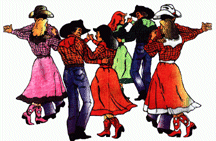
Another area of the USA in which a pre-cursor to linedancing evolved was the New England region where, in the early 1800's, "Contra" dances appeared. Contra dancing can be directly traced back to European folk dances. In contra dancing, the dancers formed two lines, a line or men and a line of women. Contra dancing still survives today and was featured in "Grease" with John Travolta. The traditional European Contra dancing was itself, in turn, derived from the English "Country Dancing", a particular form of English folk dancing. English Country Dancing existed as far back as 1650 when a book of 'dance sheets' was published and the dances were a familiar feature in Queen Elizabeth's (the 1st) court. In France this form of dance became known as Contre and Contra in Italy.
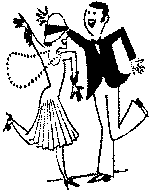 In
the 1960's several dances appeared that could, with a bit of a stretch
of the imagination, be called linedances. In the mid 1960's people were
doing a dance called "Hully Gully" - which included standard steps
and was danced in lines. Like the disco linedances from the 1970's, it
was not, however, specifically choreographed but 'evolved' on the dance
floors. Another such dance was the "Bunny Hop", appearing in the early
1960's. Of course here the distinction between linedancing as such and
Contra Dancing (it's most obvious parent) becomes somewhat murky. Many
have dismissed these dances as fad's which have not lasted the time, however
such claims should be very carefully used since most genuine linedances
also last only a relatively short time. "The Stroll", popular from
the 1940's to the 1960's (and which featured in "Grease"), could
perhaps be considered an intermediate form between linedancing and contra
dancing, containing distinct elements of both. Incidentally, the "Hully
Gully" is still around today and is being taught as a linedance. A
step-sheet exists for the dance, tho' obviously it was written long after
the dance first appeared. For those interested, the dance starts with the
right foot and consists of a vine to the right ending with a kick, a vine
to the left ending with a kick, step forward, hold, step forward, hold,
vine forward with a 1/4 turn right & ending with a kick, a vine back
ending with a hold. The 4-wall dance is 20 counts. Whether this was the
original dance or not, I'm unsure.
In
the 1960's several dances appeared that could, with a bit of a stretch
of the imagination, be called linedances. In the mid 1960's people were
doing a dance called "Hully Gully" - which included standard steps
and was danced in lines. Like the disco linedances from the 1970's, it
was not, however, specifically choreographed but 'evolved' on the dance
floors. Another such dance was the "Bunny Hop", appearing in the early
1960's. Of course here the distinction between linedancing as such and
Contra Dancing (it's most obvious parent) becomes somewhat murky. Many
have dismissed these dances as fad's which have not lasted the time, however
such claims should be very carefully used since most genuine linedances
also last only a relatively short time. "The Stroll", popular from
the 1940's to the 1960's (and which featured in "Grease"), could
perhaps be considered an intermediate form between linedancing and contra
dancing, containing distinct elements of both. Incidentally, the "Hully
Gully" is still around today and is being taught as a linedance. A
step-sheet exists for the dance, tho' obviously it was written long after
the dance first appeared. For those interested, the dance starts with the
right foot and consists of a vine to the right ending with a kick, a vine
to the left ending with a kick, step forward, hold, step forward, hold,
vine forward with a 1/4 turn right & ending with a kick, a vine back
ending with a hold. The 4-wall dance is 20 counts. Whether this was the
original dance or not, I'm unsure.
The distinction between contra dances and linedances is further clouded in that the linedancing scene also includes partner dances. Whilst the average non-American linedancer probably will never encounter a partner "linedance", it's a very different story in the USA where partner "linedances" are very much part of the scene. I put linedance in quotes tho' because strictly speaking, while part of the linedance scene, these dances are not linedances - most are not even done in lines but instead in circles and so these dances really belong to other dance styles. The classic example of the circle partner "linedance" is the "Barn Dance", originally (or at least previously) called "Old Country French Dance", which was most likely derived from an old folk dance via the square dancing scene. In Australia the same process of evolution gave rise to the style of dancing called "Bush Dancing", a synthesis of Irish, English and Scottish folk dancing and is generally done to old-style Australian country music - which evolved separately from that in the USA and from the same roots as "Bush Dancing" - both have a very distinct Irish character.
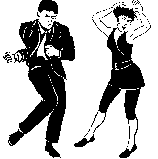 On
the disco floors of the 1970's, the form of dance that we know of today
as "linedancing" was most likely born. Of course, it was not until latter,
in the 1980's, that the term "linedancing" was coined and used. These early
'linedances' from the 1970's included dances such as the "Bus Stop"
and "Nut Bush". Like the linedance-contra crossovers of the 1960's,
these dances were not choreographed and evolved on the disco dance floors,
much as any disco/club dance evolves. Similar spontaneous linedances continue
to appear - late in 2002 such a dance appeared in Europe to "The Ketchup
Song" by Spanish group Las Ketchup. This 'club dance' is not to be
confused with several linedances choreographed to the same song.
On
the disco floors of the 1970's, the form of dance that we know of today
as "linedancing" was most likely born. Of course, it was not until latter,
in the 1980's, that the term "linedancing" was coined and used. These early
'linedances' from the 1970's included dances such as the "Bus Stop"
and "Nut Bush". Like the linedance-contra crossovers of the 1960's,
these dances were not choreographed and evolved on the disco dance floors,
much as any disco/club dance evolves. Similar spontaneous linedances continue
to appear - late in 2002 such a dance appeared in Europe to "The Ketchup
Song" by Spanish group Las Ketchup. This 'club dance' is not to be
confused with several linedances choreographed to the same song.
These early disco linedances were linedances in every sense of the word,
as used today, with the exception that they were not intentionally choreographed.
Arguably one can claim their appearance heralded the birth of linedancing,
although it's probably more correct to say their appearance was the last
of the labour pangs in linedancing's birth.
Birth
With the coming of the 1980's, linedances of a sort had already been around for quite a few years. But it was in the early 1980's that linedancing, as it would be recognised today, was born. In 1980 Jim Ferrazzano choreographed the "Tush Push", which is one of the most well known linedances today. It was, however, originally choreographed to 1940's big-band style music. This is the first known choreographed linedance (as distinct from dances that 'evolved' on the dance floor).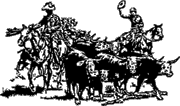
Also in 1980 two dances were choreographed in Texas by Jimmie Ruth White, "The Travelling Four Corners" and the "J.R. Hustle". Whilst these dances in their original form were Square Dances, they were quickly adapted to linedancing. These dances were born out of the Country & Western dance scene and, obviously enough, were done to country music. This adaptation as linedances of dances of other styles proved to be the source for many of the recognised early linedances. Many folk dances were adapted to country music and given new names such as "Charleston Cowboy", the "Alley Cat", "Wild, Wild, West" (Barn Dance). This adaptation was especially driven by the release of the movie "Urban Cowboy" in the early 1980's and featuring John Travolta which inspired the "Cotton-Eyed Joe", the "Two Step" and several other linedances.
 In
1981 the Oakridge Boys released "Elvira". By 1985 the dance of the
same name and it's several variations (Electric Slide, The Freeze,
etc.) were common. Just when the dance was choreographed is unknown - the
earliest known step description dates to 1985, but the dance probably dates
back to 1981 or 1982. The 1985 step-sheet was not one that would be familiar
to linedancers today - instead of a step description, the sheet was diagrammatic.
In
1981 the Oakridge Boys released "Elvira". By 1985 the dance of the
same name and it's several variations (Electric Slide, The Freeze,
etc.) were common. Just when the dance was choreographed is unknown - the
earliest known step description dates to 1985, but the dance probably dates
back to 1981 or 1982. The 1985 step-sheet was not one that would be familiar
to linedancers today - instead of a step description, the sheet was diagrammatic.
In these early years linedancing was by no means intimately connected with country music and the country music scene. Some dances were done to country music, but most were done to contemporary music - pop and rock 'n roll. Some of the most popular dances from the 1980's include "Copperhead Road", done to the rock song of the same title by Steve Earle, "Cruisin" to the pop song "Still Cruisin" by the Beach Boys and "Mustang Sally" done to the R&B track of the same name by The Commitments.
Of course, not all of the dances from the 1980's were to non-country tracks. There were quite a few dances done to country music such as Bill Bader's "Bootscoot Boogie" (1990)
Perhaps the final word on the birth of linedancing should go to one of the best known members of the world linedance community, Bill Bader:
"Line dance history is like human history - there's pre-history and then there is written history. Line dancing's true history starts with the first dances written down, and that is commonly accepted as 1970's unless someone can produce an earlier source. And that's always the challenge in history ... besides sorting out myth from reality."
Evolution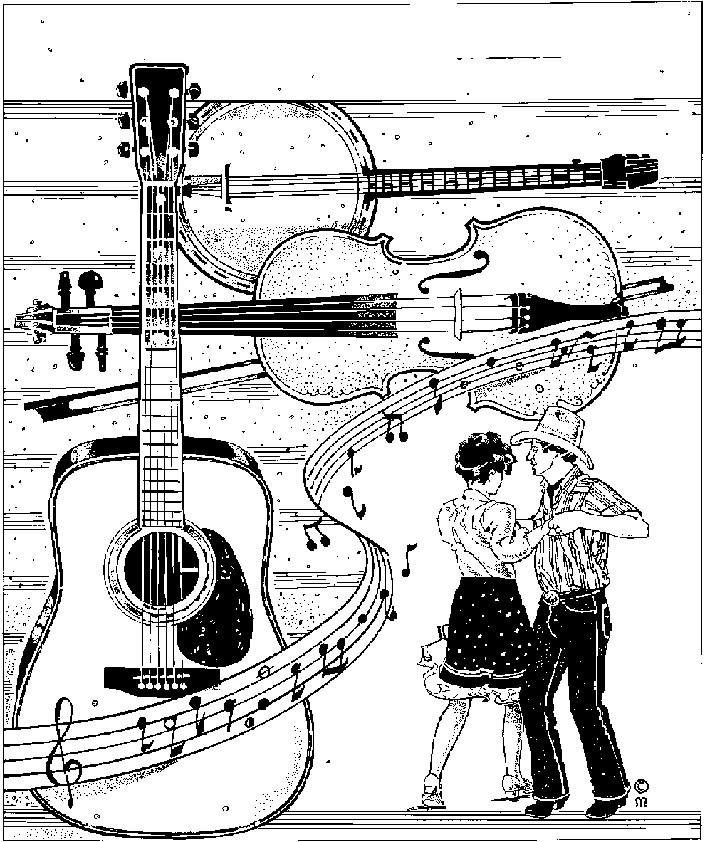
In 1992 Billy Ray Cyrus made a career change and shifted from county to
country-pop, a move many other's have followed since then (and he was by
no means the first). The fact that Cyrus latter regretted this shift and
with his next album, was back to his earlier, pure country style, perhaps
says something about country-pop, but that's another issue. As part of
the promotion for his song, "Achy Breaky Heart", Melanie Greenwood
was asked to choreograph a dance to the song. The rest, as they say, was
history. The song went on to become Cyrus' biggest ever, indeed one of
the biggest 'country' songs of the 1990's. The huge success of the song
also brought linedancing into the awareness of the general public. What
was, in the 1980's, just another disco/club dance style and not an especially
popular or even well known one at that, suddenly became the latest fad
dance style. Linedancing was suddenly "in", all around North America, Australia
and Europe classes sprang up and venues began to cater to the linedancing
crowd. It is somewhat ironic that something used to promote a song was,
in turn, promoted by the song and has indeed survived long after the song
has vanished into the obscurity of dusty record collections. Talk about
being lifted up by one's own bootstraps, but linedancing as it's known
today was exactly that!
Linedancing was not just "in", but thanks to it's connection to Cyrus' song, it became identified with country music. In the early 1990's, linedancing was done to country music, almost everything about linedancing was 'country'. Given this new found connection with country music, it was no surprise that linedancing then began to spread around the world via the country music scene. In Europe and Australia, where you found country music fans, you would also find many of them linedancing.
Soon after there was a deluge of linedances choreographed to country tracks - needed to meet the demand of all the country fans who had decided to give linedancing a try in the wake of "Achy Breaky Heart". "Bar Room Romeo" (1992/1993), "Waltz Across Texas" (1992), "Thunderbolt" (1992), "Hot Tamales" (1993), "Chattahoochee" (1993), "God Blessed Texas" (1993) and many, many more. Linedancing took off in Australia in 1992/1993 when a number of now well known linedance personalities started teaching and/or choreographing. As far as I know, Gordon Elliott was the first, in 1991. Within two years he was joined by Tracie Lee, Terry Hogan, Simon Ward, Greg North, Julie Talbot, Lance Pritchard and others. Some of the early Aussie linedances included "The Outback" (1993), "Girl's Night Out" (1994), "Third Rock" (1994), "Bow Legged Boogaloo", "Check Please" and "Ghost Rider".
Given the varied musical history of linedancing up to the mid 1990's, it was no surprise that in the late 1990's linedancing increasingly began to drift into other styles of music. This, for the most part, was most likely because linedancing had exhausted the market of country music fans and, with the "Achy Breaky Heart" fad fading away, new markets were needed. Plus linedance choreographers were becoming increasingly experienced and were beginning to experiment, looking to other musical styles and writing dances to songs that they liked, rather than writing dances to currently popular country songs. Whatever the reason, increasingly more and more new linedances were being choreographed to non-country music. This drift away from country has caused many a moan and whine from "purists", who evidently forget (or never knew) that linedancing only became country in the early 90's - in the 1980's a linedance was far more likely to be done to a pop song than to a country song.
This shift to non-country music was pretty universal, however the degree varied greatly from place to place. Linedancing in some areas remained (and still remains) remarkably immune to non-country music. Yet elsewhere, most notably in the UK, 'country' has almost vanished from linedancing. In England these days, at least 95% of dances are to non-country music and the traditional country linedance attire is as scarce as hens teeth (across the board, that is - there're gunna be venues that play a lot of country and one's which play none at all). Other places, such as Australia, have maintained a balance, with a mix of country and non-country songs. It should be noted, however, that at least here in Australia, the most lasting dances are almost exclusively those done to country music.
One final word on the "pop or country" issue. It is true that many of the people who got into linedancing in the early to mid 90's did so because of the country music connection. These people tended to be country music fans (and most still are today). No one can really deny that many in this "country brigade" are unhappy with linedancing returning to pop and many of those who are unhappy have voted with their feet - and left. On the other hand, there have been many who have gotten involved with linedancing since the late 90's who are not country-music fans and who do not want to dance to country songs. It is, I'm sure, that influx of non-country fans who have driven linedancing away from country. The shift away from country is not due to some sinister conspiracy, rather it just reflects the tastes of dancers. If the majority of dancers dislike a particular song, a dance done to it will never take off. I hear that in England country tracks usually clear the floor and often bring howls of complaints - on the rare occasions they're played (in most venues - I do know of exceptions). People there want pop, so they get it. This is not good news for the "country brigade", but as the saying goes, you can't please everyone. I should add that I'm a country music fan and prefer dances to country songs simply because I prefer that music, I linedance because I love linedancing, not because of the music! The same is true of the person who first got me involved in linedancing, back in the mid 90's.
Of course, all said and done, linedancing has always been and still remains most popular in the USA than any other country - it did, after all, come from the USA - and in the USA country music is the mainstream music, not pop and rock. I'm not talking about record sales here (which're mostly by teens), but what people listen too. Travel around the USA and most radio stations are country ones. Given how popular country music is in the USA and that linedancing is more popular there than anywhere else, I don't see the popular image of linedancing changing in the near future (i.e.: becoming non-country) and I suspect it may not be as good a thing as many proponents would think. Of course, in places such as England where country music really only has a fringe following and where linedancing is almost exclusively non-country, it's another matter. But on sheer numbers, there're far more linedancers in the USA than in the UK.
While many think linedancing is synonymous with country music and, indeed, most in the linedancing community itself think that that was once true, looking at the history of linedancing it is clear that 'country' is really only a phase that linedancing has passed through. The first linedances .. indeed the first decade of linedances ... were done almost entirely to pop and rock 'n roll music. Yes, there was some country too, but it was mostly pop & rock. In the 1980's linedancing was not a country thing. It wasn't until the early 90's and "Achy Breaky Heart" that linedancing became synonymous with country music. That influence lasted quite a few years, but by the end of the 1990's, it was clearly in the decline and has continued to today - in some areas the country influence has disappeared entirely. I suspect that, in time (and probably not much more time), linedancing will be done to whatever music styles are locally popular. In the UK pop and rock rule, thus linedancing is pop & rock. In the USA, country rules, tho' rock & pop do have strong followings, thus linedancing there will continue to retain a strong country character. Here in Australia, country music is, like in England, a fringe music, however linedancing remains most popular in those areas where country music has a greater following, namely the country and urban fringes. For that reason, linedancing here seems to be charting a course midway between that in the USA and that in the UK - no one style of music predominates and once ya get out of the big cities, there is a distinct country flavour to linedancing (as in what folks wear).
This diverging music taste will, in time, lead to a greater divergence in linedancing between regions. Linedancing today seems to be splitting back into it's various roots. In the UK and Europe, it's heading back to the 'disco' days: pop, dance music, hip hop and so forth - high energy, athletic dances. In the US, the country tradition remains strong and there is a trend towards simpler dances done to country songs. Will, in the future, both 'flavours' continue to be called linedancing and how far will they diverge? Will they remain similar enough that one say "it's all linedancing"? Will new styles of dancing, with new names, be born (most likely in the UK)? Who knows. As always, time will tell.
What about linedancing and the country image? The popular impression is that linedancing is 'country'. To the average non-linedancer, linedancing consists of folk dressed up in cowboy gear shuffling around to old country classics such as Slim Dusty (Australia) and Merle Haggard (USA). Some, thanks to tv and movie exposure, may have a vague impression that linedancing is done to "yeehaa" music in honky tonks, again dressed up in cowboy (or cowgirl) gear. While some linedancers do dress up in western gear (I do) and there are plenty of linedances done to music of the style of Haggard & co and to honky-tonk style music (and indeed many American honky tonks do host linedancing), as any linedancer would know, these are only part of the whole scene. Why do non-linedancers see linedancing as this? Almost certainly the very things that made linedancing popular in the first place, first "Urban Cowboy" in the early 1980's, but most especially the advent of "Achy Breaky Heart" in 1992. These gave linedancing it's popularity but, at the same time, they cemented in public awareness that particular image of linedancing, an image that still remains. To non-linedancers, linedancing is still "Achy Breaky Heart" etc., linedancers still wear hats, boots and only dance to country music. Maybe if Madonna or Kylie were to use linedancing to help promote a future song, like Billy Cyrus did, then the public's image of linedancing would change from "country", tho' personally the idea of linedancing being defined by Kylie etc. al in the public's eye is one that fills me with many misgivings!
With the fading of the "Achy Breaky Heart" factor, it's not just the music that's changing, it's the attire. In the 80's linedancing was too new to have a particular clothing style, but with the boom in the early 90's it became 'traditional' to wear western attire. Wherever you went, you'd find western shirts, buckles, boots, hats and fringes. Today that look has become almost extinct in many areas, tho' it's still alive and well in the country (no pun intended). Even in the city venues, you'll still spot the occasional cowboy hat and boots are still quite common, tho' the jazz trainers are appearing everywhere. In case yer wondering .. I'm firmly in the "hats & boots" crowd.
As for the popular myth of linedancing "out west" in the 1800's USA, that is nothing more than myth. The white folks of that time did dance - some of them (just as some today dance). Some of the steps they did would be familiar to linedancers today, but basic steps are common to all dance styles. In fact, in the old Wild West, the closest thing you could probably have gotten to linedancing was some of the american indian dances!
Another trend that is evidence in the dances that are coming out is that the average level of the dances is increasing in difficulty. Dances that 5-10 years ago would have been labelled 'advanced' are today considered easy intermediate, if that. Every year sees the upper level of dances continue to increase in complexity and difficulty. Dances which only a few years ago were considered so hard that they would only be seen on the competition circuit are, today, seen on dance floors all over. Indeed, more than a few ex-competition dances have entered the popular domain. This trend is especially evident in the UK and Australia and comes with a whole slew of pro's and con's. The most obvious pluses is that it means continued challenge for the more advanced and/or more adventurous dancers, a continued growth - growth is, after all, essential for continued survival. As the difficulty increases, linedancing will become increasingly professional - in appearance, that is, not in the monetary sense. The advantage of this is that the more professional a dance form becomes, the better it's chance of survival. The downside is that as the difficulty of the average level dance increases, beginners will be increasingly left behind (as too those who have no wish to be challenged with ever harder dances) and people attempting linedancing for the first time will find it increasingly harder to pick it up. This underscores the necessity to maintain true beginner classes and the need to continue to cater to these dancers - it is from amongst their ranks that the more advanced dancers arise.
With choreographers continuing to produce ever harder dances and the
'hard core fanatics' demanding harder dances, this polarisation will continue
to grow. Will the split continue to grow until there are two groups of
linedancers ... the beginner/social crowd who dance oldies and the few
new beginner dances and the 'hard core fanatics' who're really presentation
(or performance) rather than social dancing. This polarisation is common
place in the older styles of dancing such as waltz, polka, ballet, tap
dancing, tango etc. and no doubt linedancing will follow their path. This
polarisation is evident today in the increasing difference between linedancing
as a social activity and linedancing as a competition dance form. In the
90's "comp dances" were much the same as social dances .. just a bit harder.
Today there is a world of difference, not so much in the dance steps, but
in the presentation. Competition dancing has become, in a word, professional.
This does give linedancing a respectability that it's not had in the past,
but it does mean that competition dancing is becoming increasingly irrelevant
to the non-competition linedancers.
![]()
Conclusions & comments
Just how long has linedancing been around? That all depends on how loosely you consider the question. In a very loose sense, people have been doing dances that would not be out of place on today's linedance floors for 100's even 1000's of years - dancing has, after all, been a part of human culture since before recorded history and more than a few of those ancient dances contained all the elements of modern day linedancing. More recently, linedancing can be traced to some of the line-style folk dances of the European Middle ages. Again, some of those dances could be called linedances, but one could justifiably say that they are really just folk dances that could be seen as linedances. In the 1800's USA, some folk danced in lines, but these dances were contra dances, quite distinct from linedancing. In the 1940's Contra dancing started to diverge (it's still around today) - some of the Contra dances appearing in the 1940's to the 1960's were increasingly like linedances. One could argue these dances were the first linedances, although I'm inclined to view them as "missing links" between linedancing and contra dancing (tho' they are by no means missing). In the 1970's another step in the birth of linedancing was made with the advent of the "disco linedances" such as the 'Bus Stop'. Were these linedancing? One could argue both ways .. yes and no. In one sense, linedancing was born when the word itself was first used. Just when that happened and who was the first to use the term ... that is unknown. Certainly by 1980 when the 'Tush Push' was choreographed, linedancing existed. That is the oldest known dance that is indisputably a linedance so, IMO, I would date the birth of linedancing to it's appearance - 1980. True, there are older dances which today are called linedances, but when they came out they were considered Contra dances and, arguably, linedancing is just a particular type of Contra dancing, one that has come to have an identity and standing of it's own.![]()
| Date | Comment | Dances |
| historic | Folk Dances | longways folk dances |
| about 1600 | Country Dances - England | |
| 1800's | Square dancing & Contra dances - USA | |
| late 1800's | Country & Western dancing - USA | |
| 1800's-1900's | Chorus line dances - Broadway USA | |
| 1940's-1960's | Contra dancing begins to show traces of modern day linedancing | The Stroll (1940's) |
| 1960's | Fad contra-linedances | Hully Gully, Mashed Potatoes |
| 1970's | Disco "line dances" | Bus Stop, Nut Bush |
| 1980 | First recognised linedances | Tush Push, Four Corners |
| 1981 | Oak Ridge Boys release "Fancy Free" | Elvira |
| early 1980's | Urban Cowboy - start of country influence | Cotton-Eyed Joe, Two Step |
| late 1980's-1992 | Rock 'n Roll & pop linedances predominate | Copperhead Road, Cruisin', Electric Slide, Mustang Sally |
| 1992 | Achy Breaky Heart - linedancing becomes synonymous with country music | Achy Breaky Heart |
| mid 1990's | deluge of country linedances | Waltz Across Texas, Linda Lu, Hot Tamales, Midnight Waltz, Dance Ranch Romp, Cowgirl's Twist, Smokey Places etc. etc.! |
| 1994-1999 | drift away from country music begins | 13 MWZ, Cha Cha Lengua, Hey Bruce, Coastin', Quando When Quando, Red Hot Salsa, Funky Town etc. etc. |
| 2000's | linedancing a mix of music styles |

Some sources:
• The Phoenix Western Line Dance Club, http://www.phoenixwldc.itgo.com/about.html.• Swinging Cowgirls - linedance history, http://www.swingingcowgirls.com/uk-linedance_history.htm.
• "A History of Line Dancing", by Rick Bowen. Copies may be found at the following sites: Western Square dancing: http://www.dosado.com/articles/ldhist2.htm, Country Time Dance Lines: http://www.country-time.com/ldinfo/history.htm and the Rec.arts.dance FAQ, section on Line Dance: http://wwweijkhout.net/rad/dance_specific/linedance.html.
• The Linedance FAQ: http://www.io.org/~rfielder/dance_faq/contents.htm.
• "Truth or Tosh: Did Cowboys ever Linedance?", author unknown. originally appeared in Linedancer Magazine, issue 11, April 1997. Copies may be found at the following sites: Tulsa Shuffle Line Dance Club: http://www.btinternet.com/~tulsashuffle/articles/ldhistory1.html, Linedancer Magazine: http://www.linedancermagazine.com/text/articles/history.html and Western Square Dancing: http://www.dosado.com/articles/ldhist.htm.
• "Line Dancing - a Legitimate Art Form?", Mid Canterbury Dancing Cowboys, http://www.ashburton.co.nz/linedancing/history.htm.
• "Linedance History", Mike Taylor, http://www.gutz.ch/western/Various/Linedancehistory-TylorM.htm.
• "Line Dancing", BBC on-line Community Guide, http://www.bbc.co.uk/dna/h2g2/A669512.
• "A Line Dance Time Line", Doris Volz, http://www.linedancefun.com/timeline.htm.
• Entries for: 'Dance', 'Popular & Social Dance', 'Folk Dance' and 'Country Dance', Microsoft Encarta. Copyright © 1994 Microsoft Corporation, © 1994 Funk & Wagnall's Corporation.
• Posts to the Europe/world linedance mail-list, <line-dance@europe.std.com>, in the thread titled "Origins of line dance". Posters include (some posted more than once a day): Bill Bader (20/8/2001, 21/8/2001), Jana Freed (20/8/2001, 21/8/2001), B. Rand (20/8/2001), Pete McCracken (20/8/2001), Ron Klegman (20/8/2001), Lana Harvey (20/8/2001), Rich Barnett (20/8/2001), Dodee (21/8/2001), Audrey (21/8/2001) & Pat. E (21/8/2001). Also thread discussing origins of the Barn Dance: Bill Bader (30/10/2001), Lana Harvey (30/10/2001) & Linus Ellis (30/10/2001).
• Viewpoint articles on Lynne Schapiro's website "The Grapevine Connection", http://www.grapevineconnection.co.uk/.
• "Australian Line Dancing Directory", Vol's 1 & 2, Gordon Elliott & David Bowers, Div's Publications, 1995 & 1997.




























